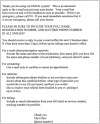A content analysis of e-mail communication between patients and their providers: patients get the message
- PMID: 15064295
- PMCID: PMC436072
- DOI: 10.1197/jamia.M1445
A content analysis of e-mail communication between patients and their providers: patients get the message
Abstract
Objective: E-mail use in the clinical setting has been slow to diffuse for several reasons, including providers' concerns about patients' inappropriate and inefficient use of the technology. This study examined the content of a random sample of patient-physician e-mail messages to determine the validity of those concerns.
Design: A qualitative analysis of patient-physician e-mail messages was performed.
Measurements: A total of 3,007 patient-physician e-mail messages were collected over 11 months as part of a randomized, controlled trial of a triage-based e-mail system in two primary care centers (including 98 physicians); 10% of messages were randomly selected for review. Messages were coded across such domains as message type, number of requests per e-mail, inclusion of sensitive content, necessity of a physician response, and message tone.
Results: The majority (82.8%) of messages addressed a single issue. The most common message types included information updates to the physicians (41.4%), prescription renewals (24.2%), health questions (13.2%), questions about test results (10.9%), referrals (8.8%), "other" (including thank yous, apologies) (8.8%), appointments (5.4%), requests for non-health-related information (4.8%), and billing questions (0.3%). Overall, messages were concise, formal, and medically relevant. Very few (5.1%) included sensitive content, and none included urgent messages. Less than half (43.2%) required a physician response.
Conclusion: A triage-based e-mail system promoted e-mail exchanges appropriate for primary care. Most patients adhered to guidelines aimed at focusing content, limiting the number of requests per message, and avoiding urgent requests or highly sensitive content. Thus, physicians' concerns about the content of patients' e-mails may be unwarranted.
Figures
Comment in
-
Help for physicians contemplating use of e-mail with patients.J Am Med Inform Assoc. 2004 Jul-Aug;11(4):268-9. doi: 10.1197/jamia.m1576. J Am Med Inform Assoc. 2004. PMID: 15252925 Free PMC article. No abstract available.
References
-
- Moyer CA, Stern DT, Katz SJ, Fendrick A. “We got mail”: electronic communication between physicians and patients. Am J Managed Care. 1999;5:1513–22. - PubMed
-
- Moyer CA, Stern DT, Dobias K, Cox DT, Katz SJ. Bridging the electronic divide: patient and provider perspectives on e-mail communication in primary care. Am J Managed Care. 2002;8:427–33. - PubMed
-
- Neill RA, Mainous AG, IIIClark JR, Hagen MD. The utility of electronic mail as a medium for patient–physician communication. Arch Fam Med. 1994;3:268–71. - PubMed
-
- Nelson R, Stewart P. Use of electronic mail as a clinical tool. J Health Care Inf Manage Syst Soc. 1994;8:33–6. - PubMed
Publication types
MeSH terms
LinkOut - more resources
Full Text Sources
Medical



